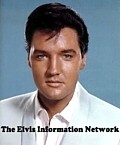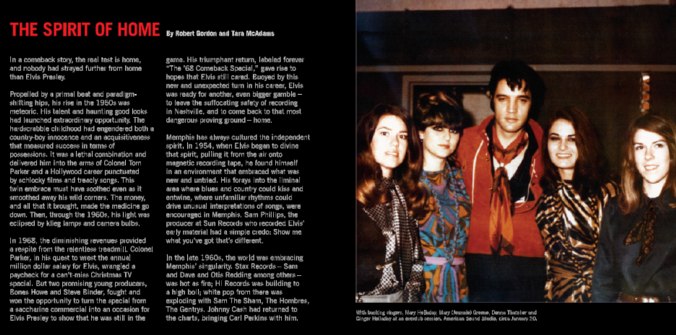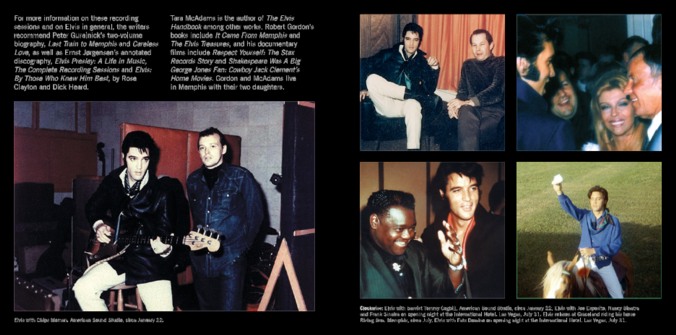| |
From Elvis In Memphis
(40th Anniversary Legacy Edition)
RCA Legacy 88697514972 (the original albums and the original mono masters)
Other CD Reviews by
|
The King Reclaims his Throne! - Other media reviews of this classic release.
(CD Review) ELVIS PRESLEY - From Elvis in Memphis
(Evan Schlansky, AmericanSongwriter.com)
(RCA/LEGACY)
Rating: 5 stars!!!
Recorded at the dawn of 1969 at American Sound Studios, From Elvis In Memphis is considered one of Elvis’s very best records, if not the best. It was his first non-soundtrack album in six years, and followed on the heels of the King’s triumphant NBC comeback special that brought his career out of the doldrums. |
 |
The reissue contains remastered versions of every track to come out of the storied sessions. Elvis poured all of his passions into each cut, including the #3 hit “In the Ghetto,” the story of “a hungry little boy with a runny nose” who turns to a life of crime, written by Mac Davis. An ace backing band and inspired production by Memphis legend Chip Moman helped set the stage for Presley’s return to glory, 34 albums into his career. Country, blues, and soul are the predominant styles here.
The raw-voiced opener “Wearin’ that Loved On Look” (a somewhat risqué image from the King) announces a departure from Presley’s smooth-voiced crooner role from the movies. Elsewhere, he puts his back into Jerry Butler’s 1968 r&b hit “Only the Strong Survive” and the classic country songs “I’ll Hold You in My Heart” and “I’m Movin’ On,” a No. 1 hit for Hank Snow in 1950. His pitch-perfect cover of Burt Bacharach’s “Any Day Now” is an attempt to get with the times. The first disc of the reissue also includes covers of “I’ll Be There” and The Beatles’ “Hey Jude,” well worth a listen for any Elvis fan.
The songs are quirkier on disc two, which offers ten tracks that didn’t make the LP. “Like my dad, there’s a dream in my brain,” Presley sings on the melodramatic “Inherit the Wind,” written by Eddie Rabbitt, “In the morning I’ll have to leave again. That’s how it is when you inherit the wind.” The bitter blues “Stranger in My Own Hometown,” which concerns “so-called friends who stop being friendly,” gets to the heart of Elvis’ pain, and he gives it all he has on the country classic “From a Jack to a King.”
The lead guitar mimics a sitar on “You Think of Me,” a subtle reminder of the year in which it was cut. Audiophiles will appreciate the 10 bonus mono singles that come with disc two, including non-album tracks like “Kentucky Rain,” and “Mama Like the Roses.” The Memphis sessions also produced the unforgettable “Suspicious Minds” (included here), which would be released as a single that summer, and gave Presley the last chart-topping hit of his lifetime.
Evan Schlansky, AmericanSongwriter.com - (Sep 2009)
| Elvis Presley’s 1969 Music Is “Ghetto” Fabulous: At 34 years old, Elvis Presley was riding a wave of renewed interest when he returned to Memphis
for several recording sessions in early 1969. Just weeks earlier, his landmark ‘68 Comeback Special found him in superb voice and boisterous spirits. Suddenly, millions of curious TV viewers wondered what was coming next. Forty years later, who could forget? “In the Ghetto,” “Kentucky Rain” and “Suspicious Minds” — all recorded in Memphis — became his first million-selling singles in nearly eight years.
From Elvis in Memphis: The Legacy Edition, a two-disc set released on July 28, compiles all of the recordings from those invigorating sessions at American Studios. More importantly, it captures a moment in time when Presley took his creative direction from producer Chips Moman, who refused to back down to Col. Tom Parker or anyone else in Presley’s entourage.
|
 |
As was his custom, Parker wanted a portion of the publishing royalties for “Suspicious Minds.” Moman not-so-politely declined. Indeed, he nearly canceled the session. If you can believe it, Presley’s handlers also tried to dissuade him from recording “In the Ghetto,” thinking its social commentary might lose some fans. Again, Moman prevailed with psychological trickery. (With so many colorful characters, the liner notes are a lot of fun to read. And you gotta love the photos.)
Presley’s attitude and charisma in “Wearin’ That Loved On Look” and “Only the Strong Survive” are completely endearing and I can almost picture him crooning “I’ll Hold You in My Heart” with a smirk, taking himself only half-seriously. Country fans may recognize songs like “I’m Movin’ On,” “Gentle on My Mind,” “True Love Travels on a Gravel Road,” “Any Day Now” and “From a Jack to a King,” yet nobody sings them quite like Elvis.
That’s why this anniversary collection is essential to anyone interested in Presley’s musical legacy.
(CD Review, Source: Craig Shelburne, CMT)
Dust Off Those Grooves (Back In Memphis) - review by Jeremy Richey: It seems like every great artist has at least one album in their catalogue that is universally ignored due to the greatness of the album that proceeded it.
How often is The Stones’ "Goat Heads Soup" mentioned in the shadow of "Exile On Main St." or how about the third Oasis platter "Be Here Now" after:"What’s The Story Morning Glory?"
All the great ones from The Beatles and The Beach Boys up to The White Stripes and Radiohead have made great works that have suffered simply due to comparison.
|
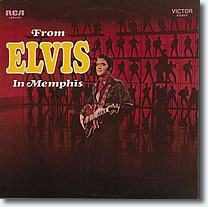 |
January and February of 1969 is a month that occupies a special place in rock history, specifically 6 days in January and 5 days in February. These 11 days would mark the legendary Elvis Presley American Studio sessions in Memphis, Tennessee. Much has been written about these sessions, Elvis Costello would label the performances supernatural and I’m not sure a better word could have been chosen to describe them.
The American sessions are the sound of an artist at not only his absolute peak but reaching past it. Elvis in that studio is Picasso in his Blue Period and Hemingway writing Old Man And The Sea. This is the sound of a man coming out of a self imposed shell and re-discovering magic, a man getting his soul back against all obstacles.
There has never been a voice as pure as Elvis’ during these sessions. Rumor has it that he had a cold early on when in one night he layed down "Long Black Limousine", "This is The Story" and "Wearin That Loved On Look". Listening to these songs you can hear the sound of a man shaking off the shackles of a long imprisonment, the voice that Dylan said would break you out of your own prison. No-one has ever been as good as Elvis in these hours of recording.
To many rock and music historians the only album that came out of these sessions was "From Elvis in Memphis". It’s the album that typically pops up on the great all time albums lists and it is the lp that is remembered. It is often overlooked that there was a second album, a work that has long since almost vanished into obscurity even though it features some of the greatest performances of Elvis Presley’s career.
"Back In Memphis", with it’s dark live photo of Elvis looking like a ghost coming back for war, was originally issued as part of a set called "From Vegas To Memphis". One record recorded live in Vegas while the studio sessions lay nearly hidden in the back sleeve. History has placed these ten tracks as near outtakes to the great "From Elvis In Memphis" sides but a closer inspection not only reveals ten great tracks but one of the most cohesive records Elvis ever delivered.
The opening, Eddie Rabbit penned, track "Inherit The Wind" sets the tone. Like other albums I have focused on in this series, from "Watertown" to "Houston", we are dealing with a man in isolation. Backed by the incredible American studio house band, including the great Reggie Young on guitar, Elvis is in top from here. The backing female vocals give the song a strange feel that is complimented by the string section that producer Chips Moman would add on later. The song’s odd time signatures coupled with Moman’s production gives the song a perfect swaying feel that is punctuated by Elvis’ reminder of what it’s like to indeed Inherit the Wind.
"This is The Story" follows, and this as mentioned dates from that first historic night Elvis stepped into American studios. The tragic tone is set here for the album, and when Elvis sings ‘but the words that I’m reading could apply to myself’ we realise why he didn’t have to be a songwriter, once he sang a song it was his, they were his autobiography.
Percy Mayfield’s startling "Stranger In My Own Hometown" follows. This is the most rocking track on the album and the most haunting. This is the sound of a man confronting a city that had witnessed the assignation of Martin Luther King less than a year earlier. Elvis’ sorrow at this event has been recounted by both Celeste Yarnall and Jerry Schilling, perhaps more than "If I Can Dream" this is his reaction to it. It’s an explosive, surging performance that stands with his greatest work. The song’s ferocious climax features one of the strangest horn arrangements ever put on vinyl and Elvis screaming off mike ‘Blow your brains out.’ He would revisit this song later in his career and re-invent the idea of a blues man in a frightening laid back chronicle of alienation and despair. Anyone who doesn’t understand the genius of Elvis Presley should listen to this song.
"Just a Little Bit Of Green" and Elvis’ lovely reading of Neil Diamond’s great "And The Grass Won’t Pay No Mind" are sublime examples of sixties pop at his best. More importantly the album never loses it’s chronicling of a man who has denied love. Every track leads up to the album’s final upcoming declaration making this, even more than I’m 10,000 Years Old, the great Elvis concept album.
Bobby Russell’s dark and brooding Do You Know I Am with it’s near whispered vocal and far-away tambourine is the calm at the center of the storm. The regret and longing are starting to kick in and it’s the perfect opener for a side that’s yearning for forgiveness.
Ned Miller’s "From A Jack To A King" was one of Elvis’ fathers Vernons favorites. The most playful and country sounding song on the album still fits in perfectly with the idea of lost love and Elvis delivers a slyly comical rendition that provide a brief respite from the darkness that would follow.
"The Fair’s Moving On" would provide the album with some of it’s most haunting imagery, with it’s portraits of a packing and vanishing carnival and love affair. Bobby Wood’s piano playing is particularly impressive as is Moman’s kaleidoscope production that surrounds Presley’s soulful vocal.
"Back in Memphis" concludes with two of Elvis’ most impressive and greatest performances. Mort Shuman’s "You’ll Think Of Me" opens with Reggie Young on Sitar instead of guitar and it’s that instrument that takes the lead throughout the song, providing an exotic counterpoint to perhaps the most soulful vocal performance Elvis ever gave. The song was used as the b-side to the legendary "Suspicious Minds" and had remained all but hidden in the years since it’s release. It is perhaps the great lost jewel in Elvis’ crown, listening to it now it’s hard to imagine a singer more in tune with all that a song can symbolically give. No-one, not even Sinatra at his most impassioned, has melded together with a song like this one. This song is Elvis Presley.
The album closes with Danny Small’s "Without Love", and we find our narrator (and I would say Elvis himself) realizing that ‘without love, I am nothing at all’. With Bobby Wood again on piano, we find Elvis at his rawest. Paul Westerberg would later write, ‘Remember me, I used to wear my heart on my sleeve’, and he could have easily been describing Elvis singing this song. Recorded on the final night of the January sessions, and shortly before "Suspicious Minds", it gives the album an uncommonly powerful conclusion. We are still with the same person from "Inherit The Wind" but we have witnessed him changing and ultimately growing. Of all of the concept albums that have gained fame, perhaps only The Pretty Things "S.F. Sorrow" came to such a resonate and deceptively simple conclusion.
(Source: By Amber Smith/Jeremy Richey, Jan 2009)
'FROM ELVIS IN MEMPHIS: LEGACY EDITION'
FULL Details and complete tracklisting.
FROM ELVIS IN MEMPHIS: LEGACY EDITION
CELEBRATES 40th ANNIVERSARY OF AMERICAN STUDIOS SESSIONS, 36 TRACKS ACROSS 2 CDs, INCLUDING 10 ORIGINAL MONO SINGLE MASTERS
The sessions delivered a year of ‘comeback’ hits:
“In the Ghetto,” “Suspicious Minds,” “Don’t Cry Daddy” and “Kentucky Rain”
Liner notes by Memphis music historians Robert Gordon and Tara McAdams
Out July 28, 2009, through RCA/Legacy & in your local stores.
“The implicit challenge was accepted, and all sank in for hard work, real work.. The biggest hits of Elvis’ latter career came from these sessions: ‘Suspicious Minds,’ ‘In The Ghetto,’ ‘Don’t Cry Daddy,’ and ‘Kentucky Rain’… He went from selling a couple hundred thousand singles to having several hits that sold more than a million… Once again Elvis arose and again, Elvis triumphed.”
– from the liner notes by Robert Gordon and Tara McAdams
In January-February 1969, after 13 years of recording studio albums and movie soundtracks in Nashville and Hollywood, the time was right for Elvis Presley (1935-1977) to set foot once again in a Memphis studio. Those sessions at Chip Moman’s American Studios yielded a year-long string of ‘comeback’ hit singles: “In the Ghetto,” “Suspicious Minds,” “Don’t Cry Daddy” and “Kentucky Rain.”
FROM ELVIS IN MEMPHIS: LEGACY EDITION collects that entire American Studios output, and then some. The specially-designed 40th anniversary double-CD package will be available at all physical and digital retail outlets starting July 28th through RCA/Legacy, a division of SONY MUSIC ENTERTAINMENT.
The extensive 2,400-word liner notes essay for FROM ELVIS IN MEMPHIS: LEGACY EDITION was written by the homegrown Memphis team of Robert Gordon (whose books include It Came From Memphis and The Elvis Treasures, and whose documentary films include Respect Yourself: The Stax Records Story and Shakespeare Was A Big George Jones Fan: Cowboy Jack Clement’s Home Movies) and his wife Tara McAdams, author of The Elvis Handbook among other works.
Individually, disc one of FROM ELVIS IN MEMPHIS: LEGACY EDITION includes the 12 songs of 1969’s original From Elvis In Memphis LP. Among these are “In the Ghetto” (written by Mac Davis, the song that jump-started his career the next year as a Columbia Records artist), and powerful covers of Gamble & Huff’s “Only The Strong Survive” (via Jerry Butler), Johnny Tillotson’s “It Keeps Right On A-Hurtin’,” Hank Snow’s “I’m Movin’ On” (famously covered by the Rolling Stones back in ’65), John Hartford’s “Gentle On My Mind,” and Burt Bacharach’s “Any Day Now” (via Chuck Jackson).
The 12 songs are augmented by four bonus tracks, songs that showed up on various LPs over the next couple of years “Who Am I?”, “If I’m A Fool (For Loving You),” and covers of Bobby Darin’s “I’ll Be There” and the Beatles’ “Hey Jude.”
Disc two of FROM ELVIS IN MEMPHIS: LEGACY EDITION includes the 10 songs that comprised LP two of the double-LP From Memphis To Vegas – From Vegas To Memphis (more on this album below). Among these are Percy Mayfield’s “Stranger In My Own Home Town,” Neil Diamond’s “And The Grass Won’t Pay No Mind” (ironically, it was Neil Diamond who yielded his studio time at American to accommodate Elvis), Bobby Russell’s “Do You Know Who I Am?,” Ned Miller’s “From A Jack To A King,” and Mort Shuman’s “You’ll Think Of Me.”
These 10 songs are augmented by another 10 bonus tracks, grouped as The Original Mono Single Masters.
Four are (mono) reprises of songs that appeared on the aforementioned LPs: “In The Ghetto,” “Any Day Now,” “The Fair’s Moving On,” and “You’ll Think Of Me.” The other six were all originally non-LP single sides at the time of their first release: “Suspicious Minds” (the Grammy Hall Of Fame and Rock And Roll Hall Of Fame inductee, written by Mark James); “Don’t Cry Daddy” (Mac Davis) b/w “Rubberneckin’”; Eddie Rabbitt’s “Kentucky Rain” b/w Shirl Milete’s “My Little Friend”; and finally, guitarist Johnny Christopher’s “Mama Liked The Roses.”
Elvis Presley’s multi-faceted performing career underwent a heroic rebirth in 1968 and 1969, ignited by three factors: his NBC-TV “comeback” special of December 1968 (taped in June, his first live show before an audience in over seven years); his landmark sessions at Chip Moman’s American Studios in January-February 1969 (Elvis’ first official recording in his hometown of Memphis since leaving Sun Records in November 1955); and his triumphant return to Las Vegas (the International Hotel) in August 1969, which led to his return to touring for the rest of his life.
The back-story originates with the NBC-TV broadcast of “The ’68 Comeback Special.” A colossal success by every standard, the tv special (and those indelible black leather images) invigorated Elvis and everyone around him, including the two most formidable figures in his career at the time, Colonel Tom Parker (his manager) and Felton Jarvis of RCA Records (his A&R man and staff producer).
Several members of Elvis’ entourage had long-standing connections with producer and songwriter Chips Moman. As busy as Memphis and the surrounding area’s studios were – Stax Records, Willie Mitchell’s Hi Records, and in Alabama, Rick Hall’s FAME Studios and the new Muscle Shoals Sound – it was Chips’ American Studios on Thomas Street that had all but eclipsed the competition, a steady rise in business that began in 1965. Like those other studios, American had its core rhythm section of world-class players: guitarist Reggie Young, bassists Tommy Cogbill and Mike Leech, Bobby Emmons on organ, Bobby Wood on piano, drummer Gene Chrisman, plus the Memphis Horns led by Wayne Jackson and Andrew Love, and a dazzling array of background vocalists. Holding it together was Chips Moman, a songwriter (“Dark End Of the Street,” Aretha Franklin’s “Do Right Woman Do Right Man”) and experienced producer since his earliest days at Stax Records.
According to Peter Guralnick, American reportedly charted 120 hits between November 1967 and January 1971, landing 28 records on the Billboard charts in one memorable week. There were early national hits with local acts Sam the Sham (“Wooly Bully”), Sandy Posey (“Born a Woman”), the Box Tops (“The Letter”), Merrilee Rush (“Angel Of the Morning”), the Gentrys (“Keep On Dancin’”), and many others. Atlantic Records became a major client, as producer Jerry Wexler steered Aretha Franklin (“Think”), Wilson Pickett (“I’m a Midnight Mover”), Dusty Springfield (Dusty In Memphis), Cissy Houston and the Sweet Inspirations (“Sweet Inspiration”), Herbie Mann (Memphis Underground), and many other label acts to Chips’ American Studios.
A lifelong Memphis resident (since age 13) whose story – and the story of the birth of rock and roll itself – is inextricably linked for all time, Elvis Presley arrived at American Studios at the perfect moment: January 13, 1969. It was just six weeks after the NBC-TV broadcast of December 3rd, and a month after the release of the TV Special soundtrack LP, a platinum seller whose climactic closing number, “If I Can Dream,” was turning into Elvis’ first hit single since 1966.
With the exception of the impromptu “Million Dollar Quartet” session of December 1956 at Sun Studios with Jerry Lee Lewis, Carl Perkins and Johnny Cash (officially unreleased until 1990), it was the first time Elvis was recording in his hometown in over 13 years. The first results of the American Studio sessions came quickly; “In the Ghetto” was issued as a non-LP single in May 1969, and was welcomed as a platinum-selling hit.
In June 1969, 'From Elvis In Memphis' presented 12 of the 32 master recordings that Elvis completed at American Studios, climaxing with “In the Ghetto.” The album became his first gold-selling studio (non-movie soundtrack) LP since 1961.
In August, “Suspicious Minds” (b/w “You’ll Think Of Me”) was released as a new non-LP single. “Suspicious Minds” not only hit the million-selling mark, but became Elvis first #1 hit since 1962 (“Good Luck Charm”) and the last #1 of his career.
Also in August, buoyed by his comeback chain of events, Elvis kicked off a four-week run at the brand new International Hotel in Las Vegas, following Barbra Streisand’s run in the 2,000-seat showroom. Live recording over the course of six nights was produced by Felton Jarvis, and five months later in November, the double-LP From Memphis To Vegas – From Vegas To Memphis was released. |
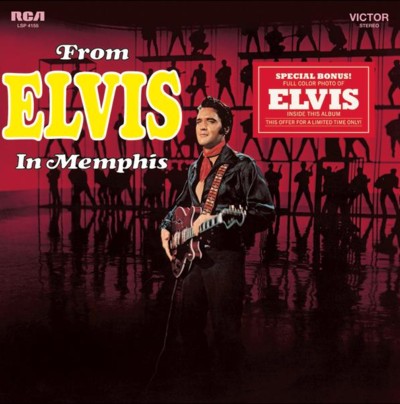 |
The first LP gathered 13 songs recorded live at the hotel; the second LP brought out another 10 of the American Studio tracks. The concurrent November single release, however, was not drawn from the album tracks. Instead, it came from the American sessions, as “Don’t Cry Daddy” chalked up another million-selling Top 10 hit. Two months later in January 1970, “Kentucky Rain” extended the string, a Top 20 gold-selling hit.
A couple of as-yet unreleased American tracks - Bobby Darin’s “I’ll Be There,” “If I’m A Fool (For Loving You)” - surfaced on Let’s Be Friends, a Camden budget LP released April 1970. In November, RCA spun off the studio half of the double-album as a single LP, Back In Memphis. In March 1971, another as-yet unreleased American track – “Who Am I” – surfaced on Elvis’ Christmas Album, also a Camden budget LP. And in February 1972, one more as-yet unreleased American track – the Beatles’ “Hey Jude” – popped up in the middle of Elvis Now. It was the last time that the non-LP American sides were heard from until the 1993 box set, From Nashville to Memphis: The Essential 60's Masters.
Elvis Presley scored a major conquest with the music he recorded at American Studios that winter of 1969, a triumphant return to his hitmaking ways in the company of another Mid-South visionary, Chips Moman. “But fires must be fed, or else they go out,” Gordon and McAdams warn. Still, “After revisiting the spirit of home, Elvis had a victory he could reflect upon, a confirmation that he was capable of more, a knowledge of the fire burning inside us all that we call hope.”
FROM ELVIS IN MEMPHIS: LEGACY EDITION by ELVIS PRESLEY (RCA/Legacy 88697 51497-2)
CD One – Selections: 1. Wearin’ That Loved On Look • 2. Only The Strong Survive • 3. I’ll Hold You In My Heart (Till I Can Hold You In My Arms) • 4. Long Black Limousine • 5. It Keeps Right On A-Hurtin’ • 6. I’m Movin’ On • 7. Power Of My Love • 8. Gentle On My Mind • 9. After Loving You • 10. True Love Travels On A Gravel Road • 11. Any Day Now • 12. In The Ghetto • Bonus tracks: 13. I’ll Be There • 14. Hey Jude • 15. If I’m A Fool (For Loving You) • 16. Who Am I?
Notes: Tracks 1-12 from From Elvis In Memphis, originally issued June 1969, as RCA 4155.
Tracks 13 & 15 from Let’s Be Friends, originally issued April 1970, as Camden 2408.
Track 14 from Elvis Now, originally issued February 1972, as RCA 4671.
Track 16 from You’ll Never Walk Alone, originally issued March 1971, as Camden 2472.
CD Two – Selections: 1. Inherit The Wind • 2. This Is The Story • 3. Stranger In My Own Home Town • 4. A Little Bit Of Green • 5. And The Grass Won’t Pay No Mind • 6. Do You Know Who I Am? • 7. From A Jack To A King • 8. The Fair’s Moving On • 9. You’ll Think Of Me • 10. Without Love (There Is Nothing) • Bonus tracks – The Original Mono Single Masters: 11. In The Ghetto • 12. Any Day Now • 13. The Fair’s Moving On • 14. Suspicious Minds • 15. You’ll Think Of Me • 16. Don’t Cry Daddy • 17. Rubberneckin’ • 18. Kentucky Rain • 19. My Little Friend • 20. Mama Liked The Roses.
Notes: Tracks 1-10 from LP Two of the double-LP From Memphis To Vegas/From Vegas To Memphis, originally issued November 1969, as RCA 6020; tracks 1-10 re-released November 1970 as single LP Back In Memphis, RCA 4429.
A sneak peak inside 3 pages of the Deluxe cover....
EIN NOTE: - Great news about the Mono Masters as Bonus tracks.
Looks like it will be another re-release that is worth buying - like the recent 'I Believe' BMG Gospel set.
See EIN review of 'I Believe' BMG Gospel set.
See EIN review of 'The Complete '68 Comeback Special' CD Review:
CD Review - From Elvis In Memphis (40th Anniversary Legacy Edition): From Elvis In Memphis represents Elvis's highest point recording a studio album.
Re-issued as The Memphis Record (1987) and subsequently Suspicious Minds: The Memphis 1969 Anthology (1999), in 2009 Sony BMG's Legacy series has issued a masterful 40th anniversary 2CD edition, with stunning remastering work by the legendary Vic Anesini.
EIN presents its massive 7,000 word strong analysis of Elvis' landmark album. With many great visuals from the sessions and informative sidebars, we delve deep into the music, go behind the scenes in the recording studio and discover the many aural delights of this 2009 masterpiece!
Read EIN's review |
 |
Below the BMG publicity release.
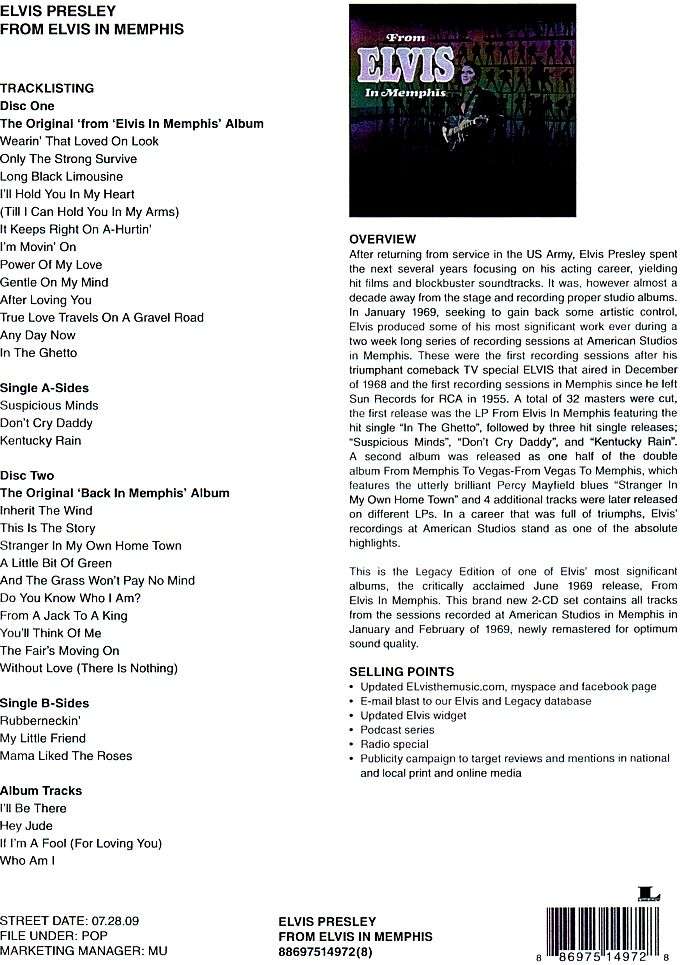
And for more on the American Sound Studio sessions check out EIN's informative articles:
'From Elvis To Garth' Bobby Wood & The Memphis Boys;
'In The Ghetto' - The 40th Anniversary:
Chips Moman's American Studios - A Turning Point In History':
EIN Review of FTD - Memphis Sessions
Article by Piers Beagley
-Copyright EIN, 2009
Click to comment
EIN Website content © Copyright the Elvis Information Network.
Elvis Presley, Elvis and Graceland are trademarks of Elvis Presley Enterprises.
The Elvis Information Network has been running since 1986 and is an EPE officially recognised Elvis fan club.
|
|



